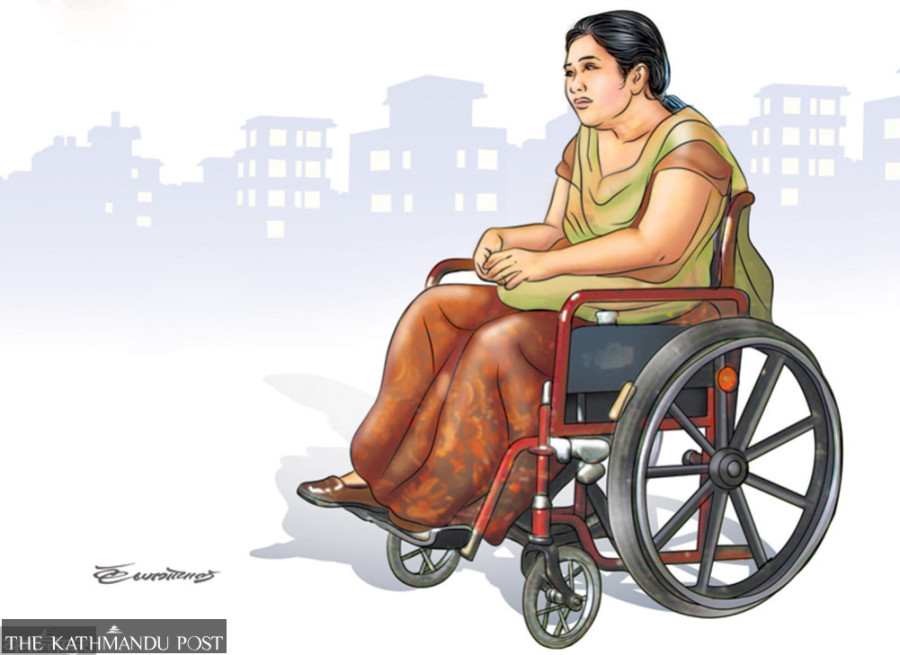Kathmandu
Navigating Kathmandu with disability is a challenge
Even the new pavements built in the metropolis do not meet the standard measurements for wheelchair use, say users.
Aarati Ray
In Kathmandu, where construction dust often clouds the air, the resumption of the pavement widening project at New Road on July 17 has elicited mixed reactions. While some citizens harbour doubts and disagreements, people with disabilities have their fingers crossed as well.
For Narayani Dawadi, who is visually impaired, the initiative offers hope and apprehension in equal measures. She worries that the Kathmandu Metropolitan City (KMC) might overlook the parameters for disabled-friendly infrastructure and execute the project superficially.
Dawadi’s scepticism is not unwarranted. Her distrust stems from her 20 years of experience navigating Kathmandu, where she has become familiar with its footpaths and pavements. Despite this familiarity, she cannot navigate confidently due to the ever-changing, unpredictable condition of the pavements.
“I don’t know if I can call the footpaths accessible,” Dawadi says. “There is tactile paving for white cane users but it’s not perfect. Sometimes they guide us to a pole or a tree, and in many places, there are only partial tactile guides, leaving us confused.”
Her experience highlights a recurring issue: lack of a reliable, consistent infrastructure for people with disabilities in Kathmandu.
The roads and footpaths that appear fine during the day are often damaged or under-construction by the evening, giving people with disabilities a hard time navigating them.
Dawadi isn’t entirely critical; she appreciates the KMC’s sidewalk widening projects and regulations on street vending and parking. Areas like Baneshwar have become much easier to navigate, Dawadi says.
However, Dawadi hopes the KMC doesn’t just displace street vendors without providing alternatives. “They need options that won’t affect their income; a crackdown won’t work.”
Dawadi emphasises that KMC shouldn’t view current projects as a complete solution to make public infrastructure ‘disabled-friendly.’ Issues like half-finished tactile paving, narrow roads, and misplaced poles and tiles need to be addressed. “People with disabilities should be involved in planning,” she says.
Rishi Dhakal, 44, a wheelchair user for the past 21 years and president of the Spinal Cord Injury Network Nepal, says that while the KMC has been building new footpaths and pavements with nice bricks and tiles, they often fail to meet the measurements for wheelchair use.
Rishi notes that the footpath in Narayantar, between Bagmati Bridge to Jorpati Chowk, has become easier for pedestrians and the visually impaired due to reduced parking and fewer street vendors. But it remains inaccessible for wheelchair users due to a lack of proper slopes.
“On many footpaths, especially at crossroads, the slope is not favourable for wheelchairs to climb,” he explains. “The footpath has become just a showpiece.”
Rishi and his organisation are working to arrange a meeting with the minister and secretary of the Ministry of Physical Infrastructure and Transport to present a memorandum advocating for wheelchair-friendly slopes on Kathmandu’s footpaths. On July 21, Rishi met with the ministry’s Joint Secretary Sushil Babu Dhakal to discuss the next steps.
While Rishi appreciates the ongoing work to widen pavements on New Road, he doubts the standard measurements for slopes and inclined planes for wheelchair users will be adhered to, citing KMC’s recent work on footpaths near Tribhuvan International Airport where the slopes are inaccessible.
Another wheelchair user, Muskan Adhikari, pointed to a double problem of inaccessibility: footpaths lack slopes, and the sky bridges are not wheelchair-friendly. Moreover, she has faced incidents where vehicles did not stop at crossings when traffic police were absent, leading to several close calls.
Rishi’s organisation has also received reports of incidents of wheelchair users being hit by vehicles in the Jorpati area.
“The constitution promises accessible infrastructure for people with disabilities to navigate independently, but the current footpaths and infrastructure makes independent travel very difficult,” Adhikari said. “Forget pavements, even government offices are not accessible.”
Rishi says that even the Health Ministry is only accessible up to the first floor, “forcing us to wait all day for meetings as ministers do not sit on the first floor.” This lack of accessibility extends to the KMC office itself, which has a metal ramp that is extremely difficult for wheelchair users to use and there is no tactile paving either.
Vishwo Shrestha, director at the Blind Youth Association Nepal, reveals that their organisation frequently receives reports of blind and visually impaired individuals falling into sewers and rivers due to inadequate safety measures.
In Sukedhara, where several offices catering to the blind community are located, a lack of proper fences along Dhobikhola river had previously resulted in accidents. The association had petitioned the KMC a year and a half ago for guard rails or road safety barriers.
“Despite the installation of guard rails, there have been recent cases of individuals falling into the river due to gaps in the barriers,” Shrestha says.
Shrestha adds that while not all incidents are reported, they receive two to three cases every two months involving falls into rivers or sewers. Many incidents involving collisions with poles or trees due to poor tactile guidance or uneven footpaths go unreported. “This reflects a major failure of the state’s duty,” he said.
Meanwhile, for 36-year-old Radha Kumal, a blind white cane user, problems in footpaths and pavements are just part of the larger problems in the country’s road infrastructure. “We don’t know where the zebra cross begins, and traffic lights are useless for us as we cannot see the colour change,” she says. Many like Kumal hope for audio signals at traffic lights to ensure safe and independent road crossings.
Sukhdev Ray, 41, who is deaf and lives in Baneshwar, points out a different but equally critical issue: lack of proper signage. “Without clear directional signs in public spaces like pavements, it’s hard for us to find our destinations,” Ray says. “As I can’t hear, I rely on signs for guidance.”
Ray also adds that many traffic lights either malfunction or are ignored by drivers. “Crossing the road can be chaotic,” he notes. “With drivers in a rush and traffic lights often disregarded, I often fear getting hit, like I was the last time.”
Ray was hit by a motorcycle while walking at Satdobato four months ago. Though he didn’t suffer major injuries, he is still reminded of the incident while walking on the road. He was also hit by a Safa tempo twice in Bhaisepati in June.
Sugam Bhattarai, general secretary of the National Federation of the Disabled Nepal (NFDN), acknowledges that the KMC’s new footpaths and railings are a step forward but “they are usually limited to major areas like New Road and lack comprehensive accessibility features.”
According to Bhattarai, in Nepal, the term ‘disabled-friendly’ often translates to just adding tactile paving and a ramp, ticking off an ‘inclusivity checklist’ without genuinely addressing accessibility needs. “What about individuals with deafness or intellectual disabilities?” he questions.
The Act Relating to Rights of Persons with Disabilities, 2017, and the United Nations Convention on the Rights of Persons with Disabilities (UNCRPD), which Nepal has ratified, mandate accessibility to infrastructure.
Article 9 of the UNCRPD says, “States Parties shall take appropriate measures to ensure to persons with disabilities access to the physical environment, transportation, information and communications, and other facilities and services open or provided to the public, both in urban and in rural areas.”
Despite these legal frameworks, implementation remains inconsistent.
Kumal shared that the ongoing pavement widening project at New Road has uprooted both sides of the road, leaving no alternative paths or assistance for the blind. “There’s no guidance or facilities for us,” she said.
Shrestha criticises the KMC’s approach for lacking provisions for the blind and visually impaired. “Construction continues without first ensuring alternative routes or proper information,” he said.
Nabin Manandhar, spokesperson for the KMC, assures that their pavement widening project at New Road includes considerations for disability access. “While we’re committed to making footpaths accessible, we’re not yet at the stage where we can address all types of disabilities,” he said.
“We’ve just started. We welcome suggestions and acknowledge that we can’t address every issue alone.”
Baburam Bhattarai, an expert member at the City Planning Commission under the KMC, emphasised that new projects adhere to disability guidelines. “We are monitoring compliance and plan to address issues with old pavements, including complaints about obstructing electric poles,” he said.
However, officials blame funding constraints as a barrier in implementing good ideas.
In 2021, the Department of Roads allocated Rs50 million for disabled-friendly pavements. The first phase (1.5km from Putalisadak to Thapathali) was completed, but the second phase at Durbarmarg and Jamal was halted due to budget constraints, according to Narayan Dutta Bhandari, division chief of the Road Division of Kathmandu.
Rishi said that they, along with the NFDN, will start monitoring construction across the capital. If the right parameters are not followed, they will negotiate with the KMC, even if it means halting the work, he said.
“We’ve learned to navigate the inconveniences in Kathmandu’s pavements and roads, but that doesn’t mean they’re not problematic,” Kumal says. “Accessible infrastructure is our right. While we do our best to adapt, we expect the government to adapt to our needs as well.”




 10.12°C Kathmandu
10.12°C Kathmandu











